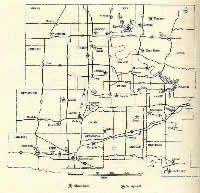|
Moderated by NW Okie! |
Volume 12 , Issue 202010Weekly eZine: (374 subscribers)Subscribe | Unsubscribe Using Desktop... |
Denoya (Whizbang), Oklahoma, Osage County

[Information on Denoya, Oklahoma is from the book written by John W. Morris - "Ghost Towns of Oklahoma".] -- Denoya (a.k.a. known as Whizbang) is located in Sec. 6, T26N, R6E, 7 miles north, 20 miles west of Pawhuska; 1½ miles north, 1½ miles west of Shidler.
The Post Office began December 31, 1921 thru September 30, 1942. The Post Office Department thought the name Whizbang was an undignified identification, so they named the new town Denoya after a prominent Osage Indian family.
The Atchison, Topeka and Santa Fe, ran through or near the town at one time, but was abandoned around 1939.
Denoya was the wildest of the boom towns that developed with the opening of the Burbank Oil Field. Denoya came into existence almost overnight after a six-hundred-barrel well was brought in just north of where the town located. E. W. Marland (later Governor and US Congressman of Oklahoma) drilled that well. The second well was a heavy gas and light oil producer. The oil would burn in an automobile. The third offset well was topped the day before Christmas.
On New Year's Day, while the crew was on vacation, the well started flowing one barrel per minute with the tools still in the hole. The only tank available was a thousand-barrel wooden storage tank. A flow line was laid to it, and help was summoned from Tulsa immediately. By dark, trucks had delivered three-inch pipe, and by three o'clock the next morning a pipeline three miles long had been laid to adequate storage facilities. The flow from the well increased to a little over twenty-five hundred barrels per day.
With an oil play of such magnitude, businesses of all kinds, desirable and undesirable, were soon established in the new town. Large oilfield supply houses were started, and a railroad was extended to Denoya. In the early 1920s there were more than three hundred business buildings ranging in size from the very small hamburger shacks to two moderately large hotels. Many people living in Denoya were not connected with oil companies. Shootings were more frequent in Denoya than in other towns in the Burbank area. The bank was robbed twice, and "it wasn't safe for a woman to be on the streets of Whizbang after dark."
Alvarado, probably the most controversial law officer to serve in an Oklahoma oil field area, was a special officer for oil companies during a part of the boom period. His name was actually Bert Bryant, he was a Texan, and he had served in the revolutionary army of Pancho Villa. During WWI he worked with General Alvarado of Mexico, and in the early 1920s he came northward to the Oklahoma oil fields. Stories of his activities describe him as everything from a cold-blooded killer to a Robin Hood. One story says that during a raid on a notorious "boarding house" he seized twenty-five hundred dollars from the woman manager. Later he returned the money to the woman in the presence of two bankers and received a receipt for it, but he was arrested for stealing it, and was finally tried and acquitted.
On another occasion, when fire started in the post office of Denoya, Alvarado refused to let the oil companies help extinguish the fire until all postal records were burned. After that the oil companies refused to help, and an entire business block was burned.
During the fire Alvarado had a shootout with a lawman from a neighboring town, probably over a married woman. The visiting lawman killed the woman and then shot Alvarado in the chest. Alvarado returned fire and shot the other man four times in the body while he was hunting for cover. Alvarado then took cover behind a merchandise-laden table that had been moved into the street from a burning store, but since his legs were exposed below the tabletop he was shot in the shins, and both his legs were broken. (The two men were taken to the same hospital; they recovered, forgot the woman, and became good friends.) This was a day in the life of Whizbang.
Denoya died almost as rapidly as it was built. In the late 1920s, as production declined, people started moving away. Good roads to large cities, changes in agriculture and cattle business, the depression of the 1930s, with the loss of property evaluation, and abandonment of the railroad resulted in the the death not only of Denoya but also of most Burbank Oil Field towns and camps. All that remains of Denoya today are foundations of some buildings and a few oil rigs. In 1975, the location of the town was marked by the remains of a few buildings and crumbling foundations.
In 1927, E. W. Marland was one of the prinicpal developers of the Burbank-Denoya field, founder of the Marland Oil Company (later Conoco), Congressman (1932-34), and governor of Oklahoma (1935-39).
Denoya, In 1924, Shotgun houses were built for workers by oil companies on leases they owned.
| View or Add Comments (4 Comments)
| Receive
updates ( subscribers) |
Unsubscribe
| © . Linda Mcgill Wagner - began © 1999 Contact Me | |
